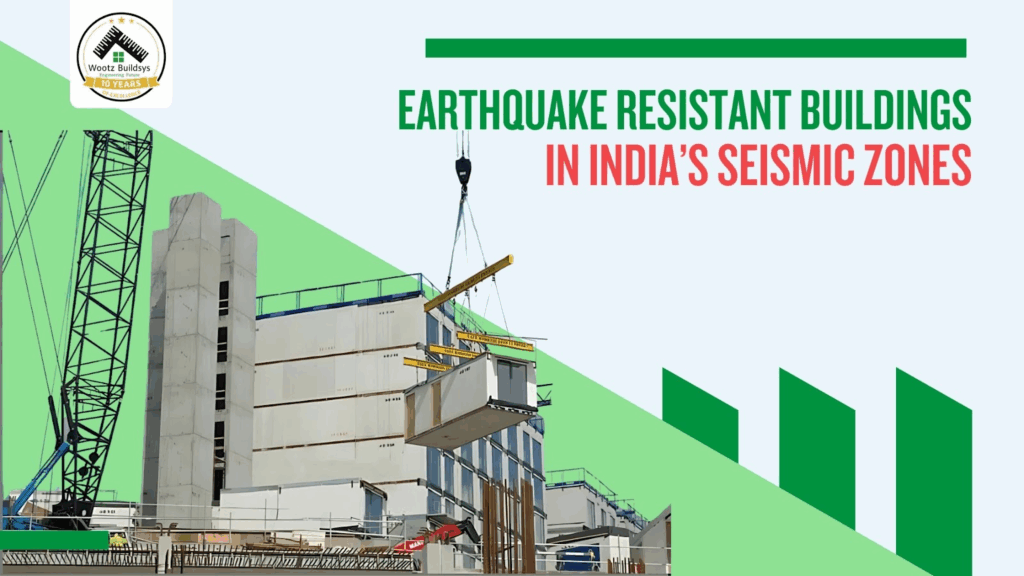
India, with its vast geography and diverse landscapes, is no stranger to earthquakes. From the Himalayan belt in the north to parts of the northeast and even some regions of central and western India, seismic activity remains a significant risk. Over the years, devastating earthquakes have caused widespread damage to life and property, raising an urgent need for safer construction practices.
This is where earthquake resistant buildings come into play. They are designed not only to withstand tremors but also to minimize casualties, protect infrastructure, and reduce long-term economic losses. In this blog, we’ll explore why earthquake resistant buildings are critical in India’s seismic zones, how they’re designed, and what they mean for the future of safe construction.
Understanding India’s Seismic Zones
The Bureau of Indian Standards (BIS) classifies India into four seismic zones based on earthquake vulnerability:
- Zone II – Low seismic risk (least active)
- Zone III – Moderate risk
- Zone IV – High risk
- Zone V – Very high risk (most active)
Regions like Jammu & Kashmir, Himachal Pradesh, Uttarakhand, the North-East states, parts of Bihar, Gujarat, and Andaman & Nicobar Islands fall under Zones IV and V. These are areas where earthquake resistant buildings are not a luxury but a necessity for survival and safety.
Why Earthquake Resistant Buildings Matter
1. Protecting Human Life
The most important reason to adopt earthquake resistant construction is to save lives. In the past, thousands of people have lost their lives due to building collapses during earthquakes. With modern engineering and design, structures can be built to withstand tremors, giving occupants time to evacuate safely.
2. Reducing Economic Losses
Every earthquake leaves behind massive financial losses in terms of destroyed homes, factories, offices, and infrastructure. Earthquake resistant buildings minimize damage, reducing repair and reconstruction costs. In the long run, this proves to be far more economical.
3. Ensuring Continuity of Services
Hospitals, schools, government offices, and industries located in seismic zones cannot afford to shut down after an earthquake. Structures designed to resist seismic shocks ensure continuity of essential services, which is crucial for recovery efforts.
4. Supporting Urban Growth
India’s cities are expanding rapidly, and many lie in seismic-prone areas. Without earthquake resistant construction, this growth could turn into a liability. Adopting seismic-safe designs ensures sustainable urban development.
5. Meeting Regulatory Standards
With increasing awareness, government bodies and BIS building codes (IS 1893, IS 4326, etc.) mandate earthquake resistant design for construction in seismic zones. Compliance is not just a legal requirement but also a social responsibility.
Key Features of Earthquake Resistant Buildings
Earthquake resistant buildings are not defined by appearance but by engineering design and material use. Some critical features include:
- Strong Foundations: Deep and well-designed foundations that distribute seismic forces evenly.
- Lightweight Materials: Reducing the overall load of a building helps minimize collapse risk.
- Flexible Structures: Designs that allow controlled movement absorb seismic shocks better.
- Reinforced Concrete & Steel Frames: Provide strength, stability, and resistance against cracks.
- Cross Bracing & Shear Walls: Add stiffness and prevent lateral movement during tremors.
- Shock-Absorbing Base Isolators: Advanced technology that isolates the building from ground motion.
Examples of Earthquake Resistant Practices in India
- Delhi Metro Infrastructure – Designed with seismic considerations, especially since parts of Delhi fall under Zone IV.
- PEB & Steel Structures – Increasingly used in factories and warehouses across seismic zones for their flexibility and resilience.
- Retrofitting Old Buildings – Older structures, especially government and educational buildings, are being upgraded with earthquake resistant features to meet current safety standards.
Future of Earthquake Resistant Construction in India
The future lies in combining technology, innovation, and sustainability. With urbanization on the rise, India cannot afford to build structures that are vulnerable to seismic shocks.
- Adoption of PEB (Pre-Engineered Buildings): Steel-based modular buildings are proving highly effective in seismic zones.
- Integration of Smart Sensors: IoT-enabled monitoring systems can detect structural stress during tremors.
- Focus on Green & Safe Construction: Earthquake resistance paired with eco-friendly design is the way forward.
- Awareness & Training: Educating architects, engineers, and builders about seismic design is essential for safer cities.
Conclusion
India’s vulnerability to earthquakes is a reminder that safety must be built into every structure we create. Earthquake resistant buildings aren’t just about withstanding shocks—they are about protecting lives, securing investments, and ensuring sustainable urban growth.
As seismic activity continues to be a reality, especially in northern and northeastern India, adopting earthquake resistant construction is no longer optional—it is the only way forward. By blending modern engineering with responsible planning, we can build a safer, more resilient future for generations to come.
FAQs
1. What makes a building earthquake resistant?
A building becomes earthquake resistant when designed with features like strong foundations, reinforced frames, shear walls, and materials that can absorb seismic shocks.
2. Which parts of India need earthquake resistant buildings the most?
Regions in Seismic Zones IV and V, such as the Himalayas, Northeast India, Gujarat, and Andaman & Nicobar Islands, need earthquake resistant buildings urgently.
3. Are earthquake resistant buildings more expensive?
Initially, they may cost slightly more than traditional construction, but they save money in the long run by reducing damage, repair, and reconstruction expenses.
4. Can old buildings be made earthquake resistant?
Yes, through retrofitting techniques like adding steel bracing, shear walls, and foundation strengthening, old buildings can be upgraded for seismic safety.
5. Are PEB structures earthquake resistant?
Yes, Pre-Engineered Buildings (PEB) made of steel are highly resilient, flexible, and better at absorbing seismic shocks compared to rigid RCC structures.
cabe4d cabe4d cabe4d cabe4d cabe4d cabe4d cabe4d cabe4d cabe4d cabe4d cabe4d rimbatoto rimbatoto rimbatoto rimbatoto rimbatoto rimbatoto rimbatoto rimbatoto rimbatoto rimbatoto rimbatoto rimbatoto cabe4d rimbatoto cabe4d rimbabola cabe4d rimbatoto cabe4d rimbatoto cabe4d rimbatoto cabe4d cabe4d cabe4d rimbatoto cabe4d cabe4d cabe4d cabe4d cabe4d cabe4d rimbatoto cabe4d rimbatoto cabe4d cabe4d cabe4d cabe4d cabe4d rimbatoto cabe4d rimbatoto rimbatoto rimbatoto rimbatoto cabe4d rimbatoto rimbatoto rimbatoto rimbatoto rimbatoto cerutu4d cerutu4d slot resmi cerutu4d situs slot kampung bet situs slot cerutu4d judi bola online toto slot situs slot gacor link slot gacor slot resmi Togel Online cerutu4d cerutu4d toto slot situs toto situs toto situs toto situs toto link slot link slot rtp slot rtp slot toto slot cerutu4d situs slot cerutu4d cerutu4d cerutu4d cerutu4d sangkarbet sangkarbet pam4d cerutu4d pam4d cerutu4d cerutu4d cerutu4d slot online jacktoto situs toto situs togel cerutu4d toto slot cerutu4d sangkarbet cerutu4d cerutu4d cerutu4d cerutu4d cerutu4d cerutu4d cerutu4d slot online cerutu4d toto slot cerutu4d cerutu4d sangkarbet situs slot idikotabangka.org link slot cerutu4d jacktoto cerutu4d situs togel terpercaya pam4d pam4d slot gacor rtp slot toto togel toto slot pam4d pam4d situs togel situs toto jacktoto toto togel toto togel situs toto jacktoto situs toto situs toto jacktoto situs slot bandar togel situs toto slot gacor grenetwork.org shortlybusiness.com cerutu4d cerutu4d cerutu4d sangkarbet cerutu4d cerutu4d cerutu4d


